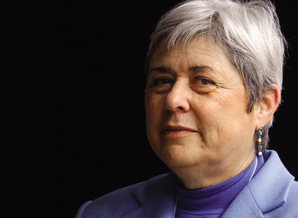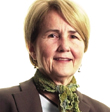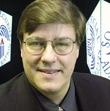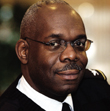10 Leaders with a knack

As manager of the Defense Department's smart-card project, <b>Mary Dixon</b> acts as a referee, balancing the needs and desires of dozens of agencies. Dixon is one of 10 winners of the first Government Computer News Management Leadership Awards, to be honored May 19 in Washington. Like Dixon, all the winners have shown a willingness to tackle tough jobs and blend confidence and humility. Read their stories...

"Make sure you surround yourself with really good people, give them clear direction, resources and responsibility and hold them accountable. The best way to manage your time is to have other people who can handle the work effectively."? Mary Dixon, manager of the DOD's smart-card program
Olivier Douliery

Donna Bonar
J. Adam Fenster

Bill Gray
Laurie DeWitt

Army Col. Jacob Haynes
Olivier Douliery

Jack Jones
Olivier Douliery

Robert Otto
Henrik G. de Gyor

George Reynolds
Phil Nelson

Mary Ann Rockey
Henrik G. de Gyor

Clint Swett
Susan McSpadden

Air Force Col. Victoria Velez
Chris Richards
As manager of the Defense Department's smart-card project, Mary Dixon acts as a referee, balancing the needs and desires of dozens of agencies. She understands that the right solution for the Common Access Card won't be everyone's ideal, but it should meet 80 percent to 90 percent of everyone's needs.
"A lot of people worry about who is right and who is wrong," Dixon said. "Sometimes you have to remember it is better to be effective than right."
Dixon is one of 10 winners of the first Government Computer News Management Leadership Awards. The winners will be honored at a GCN management conference May 19 in Washington. GCN is a sister publication to Washington Technology.
Like Dixon, all the winners have shown a willingness to tackle tough jobs. They embody a blend of confidence and humility: They're confident they can succeed, yet know they can't do it on their own. They know how to get competing organizations to adopt common goals, and they treat contractors as part of the team.
That these leaders don't take all the credit for their successes is a sign that they're excellent managers, said Renny DiPentima, president and chief operating officer of SRA International Inc. in Fairfax, Va. Before joining SRA in 1995, DiPentima was deputy commissioner for systems at the Social Security Administration.
"They realize the execution depends entirely upon people working with them as a team," DiPentima said. "Many will say thank you for the award, but say it is really the team that accomplished things. They know that the brightest light on them is the one reflecting off someone else."
From his days in government, DiPentima knows that federal managers value contractors who understand their goals and challenges. A close look at the Management Leadership Award winners offers insight into how the government's top IT managers work and what they expect from their contractors.
Here are their stories.
DONNA BONAR
Associate commissioner, Office of Automation and Program Operations
Federal Office of Child Support Enforcement
Health and Human Services Department, Washington
[IMGCAP(2)]When National Football League representatives show up at Donna Bonar's office, they come with tens of thousands of dollars in back child-support payments. Their players may not go to overseas exhibition games until they pay up.
Anyone who owes more than $5,000 in back child-support payments can't get a passport until they pay. About 60 delinquent parents are identified each day through information sharing between Bonar's office and the State Department.
Bonar's office receives information from and sends it to almost every federal agency, as well as all state work-force agencies and child support agencies. Billions of dollars in back child-support payments have been seized as a result.
All this data sharing was made possible first by a partnership between the Social Security Administration and the Health and Human Services Department. Bonar had a congressional mandate to build the Federal Parent Locator System in a year. There wasn't time to build a system from scratch, so Bonar turned to Social Security, even though such interagency collaborations were unheard of at the time.
Social Security "already had a data network running from the states in to their computer center," Bonar said. "They had the capability to maintain the volume of data we needed, and they had the systems expertise to work with us as we were developing our databases. And they have probably the most secure data center."
FPLS launched on time, bringing in employment data from the 50 states so delinquent parents could be found.
"There are always challenges in the child support program," she said, "and that's why I'm still here."
MARY DIXON
Director, Access Card Office
Defense Manpower Data Center, Arlington, Va.

To find the right smart-card solution, Mary Dixon and her team had to get smart about smart cards. The cards control access to bases and buildings as well as computer networks.
The team visited the technical staff ? not the marketing staff ? of major chip and card vendors. It also consulted organizations that had major smart-card programs, including Visa, MasterCard and the Spanish and Dutch governments.
The team defined its requirements and evaluated bids for a governmentwide smart-card contract. Then the vendors had to compete for the Defense Department's business.
With the vendors, Dixon acted as general contractor.
"We are the integrator, and the contractors are doing the work," she said. "We are maintaining control while getting the special skill sets of the contractor."
The program uses several contractors, so each can keep the other honest, Dixon said.
"They all have to cooperate to pull it off, and there is always another set of eyes looking at the work," she said. "Your whole process is more robust."
By the end of 2000, the first smart-card site was live. Now the cards are issued at about 900 sites worldwide. Dixon said she plans to meet her goal this summer of putting 4 million smart cards in the hands of military personnel and their contractors.
Ultimately, Dixon said, she will judge her success by what happens after she moves on.
"I remember my dad telling me that if you can get people to think of things as their idea, you will be much more likely to have those things continue after you leave," she said.
BILL GRAY
Deputy commissioner, Office of Systems
Social Security Administration, Baltimore
[IMGCAP(3)]When Bill Gray started working at the Social Security Administration more than 25 years ago, everything was done on paper. Since 1985, Gray has worked to computerize the agency's operations.
To speed the process, Gray cut Social Security's software development life cycle for Internet applications from 12 months to between three and six months.
"People looked at how they could do things in parallel, at how they could help each other. They were able to develop a process that met my goals. We piloted it and refined it, and now it is the standard," said Gray, who oversees 2,900 staff members, 600 contractor employees and a $510 million annual budget.
Gray's office is so well respected that he has difficulty accommodating everyone who wants to do a rotation there. "We try to give people good assignments and a lot of responsibility," Gray said.
He said he benefits two ways. First, when those people return to their offices, they have a better understanding of his organization, so there is a better foundation for discussions between the two. Second, temporary staff members bring new ideas. "Giving them the opportunity to suggest how we might improve is an opportunity for me. I really value that," Gray said.
Gray predicted that by summer 2005, most agency operations will be computerized.
"For the last 70 years, the foundation of this business has relied on paper," he said. "To be as close to getting rid of it as we are, I think, is a tremendous accomplishment."
ARMY COL. JACOB HAYNES
Program manager, Standard Procurement System
Defense Contract Management Agency, Fairfax, Va.
[IMGCAP(4)]When Col. Jacob Haynes took over the Standard Procurement System in August 2001, it was over budget and behind schedule. In 2003, more than 23,000 Defense Department procurement professionals used it to buy more than $48 billion in goods and services.
Haynes, a career military officer of 24 years, put the program back on track by moving to spiral software development, which got the software on users' desktops faster.
He also revamped software testing, which cut deployment time from seven or eight months to two months and cut deployment costs from $12 million to $5 million.
In the past, the software would be tested repeatedly without acceptance of a baseline, Haynes said. He instituted a three-tier process that involved contractor testing, independent validation and verification testing and field testing.
The decision to test at five field sites simultaneously was difficult. Haynes' advisers recommended against it, but he persuaded them that the testing was necessary to get buy-in from the services and ensure deployment on the 61st day. "In the past, the services would have done their own testing and would not have accepted the software," he said. "Now we accept software as a government, and not individually.
"If it had not worked, I would have had to accept responsibility, and the fielding would have taken a lot longer," Haynes said.
JACK JONES
Deputy director, Center for Information Technology
National Institutes of Health, Bethesda, Md.
[IMGCAP(5)]Naval flight instructors put their students in complicated, stressful situations in which they must make decisions without enough information. Successful students learn to ignore distractions, make decisions and act on them, despite the fact that they'd like more time.
"You get the idea that when there's something you need to focus on, you will exclude other things from your mind," said Jones, who was a flight navigator in the Navy.
He has consistently applied that practice in 18 years in federal information technology. As director of information processes at Sandia National Laboratories in the mid-1990s, Jones bought a $70,000 site license for an early Web browser. When the company failed, the money was lost. Jones then went with Netscape.
"You have to make changes quickly because the market changes fast," he said. "If you don't, the early adopters in your community will leave you behind. I think it's only worthwhile being at that leading edge."
Jones carried that mind-set to the National Institutes of Health. Under his leadership, NIH was the first agency of the Health and Human Services Department to provide an enterprisewide, single sign-on capability to its computer users: 26,000 people in 90 buildings. Previously, some people had more than 10 user IDs and passwords.
The enterprise authentication technology has improved IT security and saved NIH more than $2.5 million since its 2002 implementation, said Gene Cartier, vice president of SRA International Inc. in Fairfax, Va.
"When you're flying or working, you do what you can and get on with it," Jones said.
BOB OTTO
Vice president and chief technology officer
U.S. Postal Service, Washington
[IMGCAP(6)]Whenever someone says a job can't be done, that's the job that Bob Otto wants.
"They expect you to fail, so if you succeed, they'll think it's monumental," Otto said. "I've always thought of myself as No. 2, and I try harder."
Otto, who oversees a 1,300-person IT staff and a $500 million annual budget, has had many successes in his 25 years at the Postal Service.
In the last three years, Otto managed the consolidation of 119 help desks into four, the standardization of hardware, software and support services at two of the largest computer centers in the world, and cut the number of application development tools from 1,500 to 450.
He also managed the reduction of software applications from 1,000 to 650 and the Web enabling of many of those applications. Previously, applications installation happened workstation by workstation and took months. Now it's as easy as clicking on a Web browser and takes minutes.
These are a fraction of the IT improvements made under Otto's leadership. "If I say it will be done, it will be done," he said.
The toughest challenge is realizing that not everyone shares the same philosophy, Otto said.
"If a manager says, 'This will be done by 4 p.m. today,' and it's not done, I have a problem," he said. "I tell them I will accept nothing less than your best. That's what people will remember us for."
GEORGE REYNOLDS
Director of information technology
Trinity County, Weaverville, Calif.
[IMGCAP(7)]About five years after George Reynolds joined the Trinity County Data Processing Department in 1989, the county government abolished it. Before county leaders realized they'd made a mistake, Reynolds had moved to the county Health and Human Services Department, where he implemented an integrated computer system that improved financial accounting and slashed errors.
County leaders lured Reynolds back to a recreated IT department, where, as the lone staff member, he oversaw the county's systems.
That didn't work, either. Today, Reynolds has three of the four things he said he needed to stay in the job: higher pay, training and a staff of seven. He still hasn't moved out of the courthouse basement.
Under Reynolds' direction, the county got a secure network, a wireless network, a computerized library, a law enforcement application that allows sharing of reports, and a computer-training program for county employees, among other improvements.
"I was able to accomplish a lot by myself, but I'm able to accomplish a lot more with my team," Reynolds said. "In the early days, I had a boss who said, 'Why don't you just step out of the way so I can do it the right way?' I learned that you have to teach others to do it the right way."
MARY ANN ROCKEY
Head of technology and innovation, Chief of Naval Operations Readiness and Logistics Directorate
Navy, Arlington, Va.
[IMGCAP(8)]Mary Ann Rockey might have to ax some applications she developed for the Navy. She's in charge of getting rid of the redundant applications in the logistics and readiness area as the Navy-Marine Corps Intranet is rolled out.
So far, she's cut more than 12,000 of 15,000 applications.
"Joint systems are favored over Navy-unique systems," Rockey said. "The software I have worked on in my career is on the block, just like everything else."
But she said that's OK. "We're radically changing the way we manage IT in the Navy," Rockey said. "Being a part of that and, in some ways, leading that is a big accomplishment."
Persuading people to give up software hasn't been easy, but Rockey smoothed the way by developing a process for analyzing the functional, technical, cost and risk factors associated with software.
The process helps others see the logic of discarding niche, outdated and unsupported applications in favor of enterprisewide applications. Other defense units have adopted it.
"People tell me, 'If you tell me I need to use something else, that's OK, just tell me what it is. I understand what you are trying to do,' " Rockey said. "That's important to hear."
CLINT SWETT
Director, Technology Services Organization
Defense Finance and Accounting Service, Kansas City, Mo.
[IMGCAP(9)]Clint Swett's staff has learned to approach him not with problems, but with solutions.
"Failure isn't an option," Swett said. "If they say, 'If I had eight more people and a new server and this tool, I could make up the lost time,' I say, 'Let's go get it.' "
Contractors get treated the same way. "I don't have any second-class citizens here. We have different salary schedules, leave schedules and incentives, but we are all here to do the same thing," Swett said.
The staff will work until 3 a.m. if they think that a Marine's paycheck will be wrong and they can fix it, Swett said. For example, when off-the-shelf software wouldn't work and a delivery schedule was in jeopardy, one employee wrote a custom fix until the commercial product could be made to work. The rollout happened on time and enabled split payments, so Marines could get spending money while they are deployed in Iraq.
To get that kind of dedication, a leader must be willing to go the extra mile himself and never solely take credit for anything, Swett said.
"I always say 'we' -- I never say I do any of this," he said. "We as an organization have accomplished huge initiatives that have changed the way business practices are conducted by automating tasks and turning the work force into knowledge workers, as opposed to task-oriented workers."
AIR FORCE COL. VICTORIA VELEZ
Commander, Joint Interoperability Test Command
Defense Information Systems Agency, Fort Huachuca, Ariz.
[IMGCAP(10)]Col. Victoria Velez's most meaningful assignment in 22 years in the Air Force came after the terrorist attacks of Sept. 11, when she worked to build the coalition village at Central Command headquarters in Tampa, Fla. Today, more than 80 countries supporting Operation Enduring Freedom are represented there.
"It was amazing to meet our coalition partners and to know that if I didn't do my job, they couldn't do their jobs," Velez said.
In their rented trailers, the coalition partners needed the same communications capabilities as the U.S. military: faxes, copiers, computers and secure phones. They also needed a command and control system.
When the Italians bought their own satellite dish, a few other nations decided they wanted one, too, Velez said.
The Italians "were very interested in sharing. We had real cooperation right there on the ground," she said.
Velez makes sure to spread credit around for the work she's overseen.
"The people who deserve the credit are the people down in the trenches. I'm fortunate to have a really great team," she said.
Government Computer News Staff Writer Mary Mosquera contributed to the coverage of Jack Jones. She can be reached at mmosquera@postnewsweek tech.com Staff Writer Gail Repsher Emery can be reached at gemery@postnewsweektech.com.
They don't ask, 'Where'd the task order?'
Contractor support is critical to the success of government managers, in part because the government work force continues to shrink, according to the winners of the Government Computer News Management Leadership Awards. But these executives don't want just any contractor, and they're careful about the amount and the type of work they allow contractors to perform.
"We don't have anything we give solely to the contractor. We don't have anything we give solely to the government, either," said Clint Swett, who leads the Technology Services Organization at the Defense Finance and Accounting Service.
Swett said contractors would not comprise more than a third of his staff, and ideally not more than 20 percent.
"They are my flex staff," he said. "They are the fastest way to get a specific skill that we may or may not be able to grow internally."
Bob Otto said he uses contractors in the same way.
"If I don't have knowledge in wireless, they bring in knowledgeable people and allow me to get started. Over time, I can move them out," said Otto, chief technology officer at the U.S. Postal Service.
Otto also is careful not to cede core functions to contractors.
"If it is a Saturday night, and one of the programs has a problem, we have [government staff] on call that will dial in and solve the problem -- or drive in," he said. "Trying to find a contractor who may have flown home for the weekend might be unworkable."
Sometimes contractors are needed at night and on weekends, and that's when it's essential to employ a contractor that puts the government mission ahead of the company's bottom line -- a contractor that will work 70 hours a week along with the government staff, government managers said.
"We expect the private sector to make money, but if they are focused on the mission, processes and quality, it will be a win-win for everyone," said Col. Jacob Haynes, program manager for the Standard Procurement System at the Defense Contract Management Agency.
Not all contractors have this quality.
"The contractors that are here to help me be successful, if I called them in the middle of the night, they would go do it because they are my partner," Otto said. "Then there are the contractors that are just here because it is a business, and they would ask where the task order is. I would prefer that every contractor be a real partner, but it doesn't always work that way."
Haynes does market surveys and talks to other government program managers and directors to find out how a contractor will likely function on the job.
"We need contractors to be proactive," he said. "The last thing you need is someone waiting for someone to do something."
Mary Dixon agreed. She leads the Defense Department's Common Access Card program.
"I need contractors that look for ways to help me do my job better, who aren't just reacting to things I say," she said.

